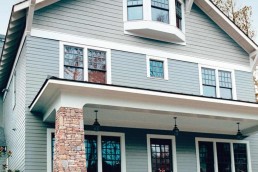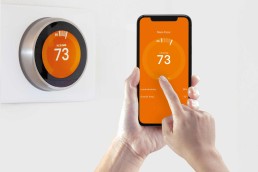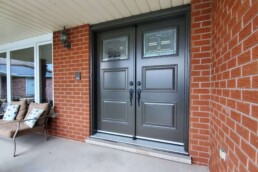In an era where sustainability and energy conservation are paramount, making your home more energy-efficient not only benefits the environment but also your wallet. From reducing utility bills to enhancing comfort and increasing your property’s value, there are numerous compelling reasons to embark on this journey. Welcome to our guide where we’ll explore a variety of strategies and improvements that can transform your residence into an eco-friendly haven. Whether you’re considering upgrading windows, doors, insulation, or even harnessing the power of solar panels, this guide will equip you with the knowledge and inspiration to take significant steps toward a greener and more energy-efficient home. Let’s dive into the world of sustainable living and discover how you can create a more comfortable, eco-conscious, and cost-effective dwelling.
Table of Contents
- Enhancing Energy Efficiency with Upgraded Siding
- Optimizing with Insulation
- Upgrading Doors for Enhanced Energy Efficiency
- Illuminating Efficiency with LED Lighting
- Efficient Temperature Control with Programmable Thermostats
- Achieving Efficiency Through Leak Sealing
- Landscaping for Energy Efficiency
- The Power of Knowledge: Home Energy Audits
- HVAC Maintenance: A Vital Component of Energy Efficiency
- Energy Efficiency Windows: Let the Light In, Keep the Bills Out
- Sun-Powered Savings: Embrace Solar Panels for a Brighter, Greener Home
- Energy-Efficient Appliances: Saving the Environment and Your Wallet
Enhancing Energy Efficiency with Upgraded Siding
Boosting energy efficiency with upgraded home siding is crucial. It’s not merely about aesthetics; it revolves around insulation and its direct impact on your energy bills. The decision to upgrade your siding can result in substantial improvements, enhancing your home’s comfort and reducing energy consumption.
Choosing the Right Material: Start by selecting the appropriate siding material. Insulated vinyl or fiber cement siding, for example, adds an extra layer of insulation, keeping your home warmer in winter and cooler in summer. These materials also enhance durability, require minimal maintenance, and contribute to long-term energy savings. Consult with professionals to choose the best siding material for your specific climate and budget.
Efficient Installation: Beyond the material, proper installation is vital for maximizing energy efficiency. Ensure that your siding is installed to seal gaps and prevent drafts, reducing the workload on your heating and cooling systems and saving money on energy bills. Upgrading your siding isn’t just about appearance; it’s about creating an energy-efficient barrier that stands up to the elements and benefits your home’s comfort and your wallet.
Optimizing with Insulation
Efficient insulation is a cornerstone of a more energy-efficient home, as it plays a pivotal role in reducing energy loss reducing energy loss and maintaining a comfortable indoor environment. There are two key approaches to insulation: internal and external. Let’s explore both, with a special emphasis on the benefits of foam insulation.
Internal Insulation: Internal insulation, often referred to as attic or wall insulation, involves adding layers of insulating material within the structure of your home. This serves as a thermal barrier that prevents heat from escaping in the winter and entering in the summer. Upgrading your internal insulation can result in significant energy savings by reducing the workload on your heating and cooling systems. Consider using materials like fiberglass, cellulose, or foam board insulation, depending on your specific needs and budget.
External Insulation with Foam: When it comes to external insulation, foam insulation stands out as a top choice. Foam insulation is sprayed or applied to the exterior walls of your home, forming a continuous, airtight barrier that minimizes heat transfer. This not only enhances energy efficiency but also strengthens your home’s structural integrity. The seamless nature of foam insulation ensures that there are no gaps or thermal bridges, reducing energy loss to a minimum. It’s a highly effective solution for climates with extreme temperature variations, offering superior insulation and remarkable energy savings over time. Consider consulting with insulation professionals to determine the best insulation strategy for your home, whether internal, external, or a combination of both, to reduce energy loss and create a more energy-efficient living space.
Upgrading Doors for Enhanced Energy Efficiency
When considering ways to enhance the energy efficiency of your home, it’s essential not to overlook the significance of your exterior doors. These entryways serve as the gateway to your home, and understanding the importance of energy-efficient doors can’t be overstated. Their efficiency plays a crucial role in determining your indoor comfort and the impact on your monthly energy bills. Opting to upgrade your doors to more energy-efficient models is a wise investment that can yield substantial improvements in your home’s thermal performance.
Choosing Energy-Efficient Door Materials: Start by selecting the right door materials. Fiberglass and steel doors, for example, offer excellent insulation and durability, making them ideal choices for enhancing energy efficiency. They are highly resistant to temperature fluctuations and maintain a tight seal, preventing drafts and heat loss. Additionally, consider doors with multi-pane or insulated glass, which further improve insulation and reduce energy transfer. When replacing your doors, ensure they are correctly installed with proper weatherstripping and a snug fit, which will help maintain the desired indoor temperature, reduce energy consumption, and keep your home cozy year-round. Upgrading your doors is not only a practical step but also a stylish one, as many energy-efficient doors are available in a variety of designs and finishes to complement your home’s aesthetic.

Find a Home Improvement Professional
Are you looking to do a home renovation and need quotes?
Illuminating Efficiency with LED Lighting
Lighting is a fundamental aspect of any home, and when it comes to energy efficiency, LED lighting takes the spotlight. LED bulbs are renowned for their exceptional efficiency, offering significant energy savings compared to traditional incandescent and fluorescent lights. Not only do LED bulbs consume far less electricity, but they also have a longer lifespan, reducing the frequency of replacements. Making the switch to LED lighting is a simple yet highly effective step in your journey towards a more energy-efficient home, as it not only reduces your electricity bills but also minimizes your environmental footprint.
Efficient Temperature Control with Programmable Thermostats
Programmable thermostats are an indispensable tool in the quest for energy efficiency. These smart devices empower homeowners to take control of their heating and cooling systems with precision. By scheduling temperature adjustments based on your daily routines, programmable thermostats can optimize energy usage, reducing heating and cooling costs while ensuring comfort when needed. Whether you’re at home, work, or asleep, these thermostats allow you to fine-tune your HVAC system, making them an invaluable addition to any energy-conscious household. Upgrading to a programmable thermostat is a straightforward way to achieve tangible energy savings and reduce your carbon footprint.
Achieving Efficiency Through Leak Sealing
When it comes to enhancing your home’s energy efficiency, one of the fundamental steps is addressing drafts and leaks that can undermine your efforts. These unwanted air leaks often occur around doors, windows, and even through cracks in the walls. While they may seem small, the cumulative effect of these leaks can lead to significant energy loss, resulting in higher heating and cooling bills. Identifying and sealing these gaps is not just about saving money; it’s also about creating a more comfortable living space.
The process begins with a thorough inspection of your home to pinpoint areas where drafts are prevalent. Common culprits include gaps around windows and doors, poorly insulated attics, and unsealed ductwork. Once identified, these leaks can be sealed using weatherstripping, caulking, or expanding foam insulation. Properly sealing these gaps not only reduces energy loss but also helps mitigate outdoor noise from entering your home, resulting in a more consistent and peaceful indoor environment. As a bonus, your heating and cooling systems won’t have to work as hard to maintain your desired temperature, resulting in both energy and cost savings. Sealing leaks is an essential step towards a more energy-efficient and eco-friendly home.
Find a Home Improvement Professional
Are you looking to do a home renovation and need quotes?

Landscaping for Energy Efficiency
The quest for a more energy-efficient home doesn’t stop at your front door; it extends to your outdoor space as well. Thoughtfully designed landscaping can be a powerful ally in your efforts to reduce energy consumption and create a comfortable living environment. Here’s how you can tap into nature’s potential to boost your home’s energy efficiency.
Strategic Planting for Climate Control: Planting trees, shrubs, and vines strategically around your home can provide natural shade in the summer, reducing the need for excessive air conditioning. Deciduous trees, for example, offer shade during hot months while allowing sunlight through during the winter. Windbreaks made of evergreen trees or shrubs can shield your home from cold winter winds, reducing heat loss and ensuring year-round comfort. By harnessing nature’s ability to regulate temperature, you can lower your energy bills while enjoying a greener, more comfortable home.
Sustainable Landscaping Choices: Embrace sustainable landscaping practices like xeriscaping with drought-tolerant plants and native species adapted to your local climate. These choices not only reduce outdoor water consumption but also require less maintenance, saving you time and effort. Incorporate reflective surfaces and hardscaping elements that don’t absorb heat, such as light-colored pavers, to keep outdoor areas cooler and minimize heat radiating back into your home. Landscaping, when done with energy efficiency in mind, can transform your outdoor space into an eco-friendly oasis that complements your commitment to a greener lifestyle.
The Power of Knowledge: Home Energy Audits
If you’re serious about enhancing your home’s energy efficiency, consider enlisting the help of a professional for a comprehensive home energy audit. This assessment involves a thorough examination of your home’s energy consumption and identifies areas where improvements can be made. During an energy audit, experts use specialized equipment to assess your insulation, windows, doors, HVAC systems, and more to pinpoint sources of energy loss.
An energy audit provides you with invaluable insights into the specific areas of your home that could benefit from upgrades or improvements, helping you prioritize your efforts and investments. Armed with the findings of an energy audit, you can make informed decisions about where to allocate your resources to achieve the greatest energy savings and create a more energy-efficient, eco-friendly home. Whether you choose to conduct a DIY audit or hire a professional, this process is a crucial step in your journey toward sustainability and energy efficiency.
HVAC Maintenance: A Vital Component of Energy Efficiency
Regular maintenance of your heating, ventilation, and air conditioning (HVAC) system is an essential aspect of achieving and sustaining energy efficiency in your home. Neglected HVAC systems can lose efficiency over time, leading to increased energy consumption and higher utility bills. Scheduling professional HVAC maintenance ensures that your system operates at its peak efficiency, reducing wear and tear on components, improving indoor air quality, and ultimately extending its lifespan. Simple tasks such as changing air filters regularly and cleaning ducts can make a significant difference in both energy savings and home comfort. By investing in routine HVAC maintenance, you not only enhance energy efficiency but also ensure that your home remains a comfortable and healthy environment for you and your family.
Find a Home Improvement Professional
Are you looking to do a home renovation and need quotes?


Energy Efficiency Windows: Let the Light In, Keep the Bills Out
Upgrading your windows can have a significant impact on your home’s energy efficiency. Consider replacing single-pane windows with double or triple-pane windows equipped with Low-E coatings to reduce heat transfer and improve insulation. Choosing the right frame material, such as vinyl or fiberglass, can further enhance energy savings. Proper installation is crucial, as it ensures a tight seal and minimizes air leakage. Additionally, window treatments like cellular shades and insulated curtains can help maintain your home’s temperature. Look for Energy Star-certified windows, and calculate the potential return on investment to make informed choices. By investing in energy-efficient windows, you can increase comfort, lower energy bills, and reduce your carbon footprint.
Upgrade your windows to enhance energy efficiency, reduce energy bills, and improve home comfort. Opt for double or triple-pane windows with Low-E coatings, choose the right frame material, and ensure proper installation. Don’t forget to explore energy-efficient window treatments and consider Energy Star-certified options. These upgrades not only make your home more eco-friendly but also increase its overall value.
Sun-Powered Savings: Embrace Solar Panels for a Brighter, Greener Home
Harnessing the power of the sun with solar panels is a smart investment in both sustainability and cost savings. By installing solar panels on your roof, you can generate clean, renewable energy and reduce your reliance on the grid. The energy captured during the day can be stored or used immediately to power your home, significantly cutting down on electricity bills. Additionally, many regions offer incentives, tax credits, and net metering programs, allowing you to earn credits for excess energy produced. Over time, solar panels not only pay for themselves but also contribute to a greener, more energy-efficient future.
Energy-Efficient Appliances: Saving the Environment and Your Wallet
Selecting energy-efficient appliances is a fundamental step toward creating an eco-friendly, cost-effective home. These appliances, often marked with the Energy Star label, consume less electricity and water while providing the same, if not better, performance. Consider upgrading your refrigerator, dishwasher, washing machine, and other major appliances to their energy-efficient counterparts. Additionally, don’t forget the small kitchen and household gadgets; even these can add up in energy savings. Over time, these appliances not only reduce your environmental footprint but also result in substantial long-term savings on your utility bills.
Find a Home Improvement Professional
Are you looking to do a home renovation project? Discover the best home improvement professionals through our extensive contractor network. Answer some questions about your needs and we will match you with qualified home improvement experts!

